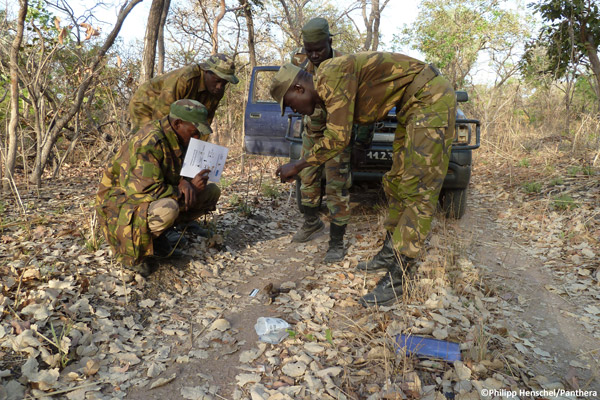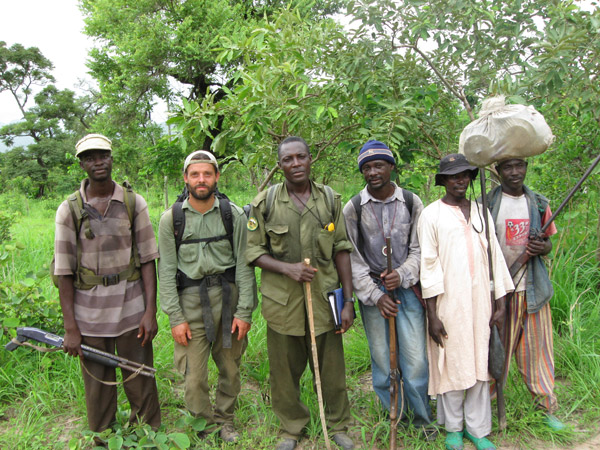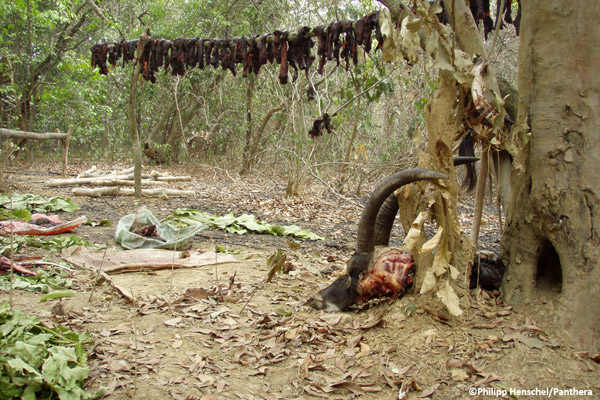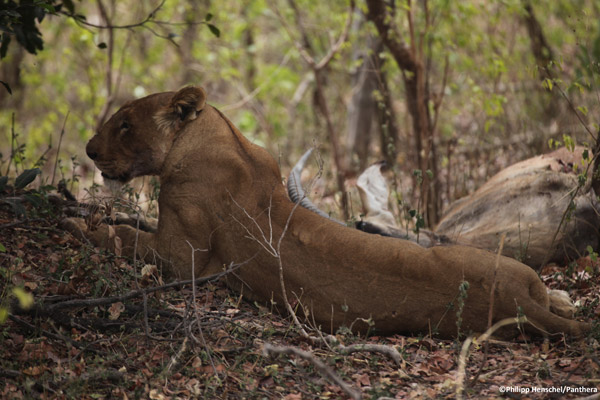Lions face extinction in West Africa: less than 250 survive

A male lion in Pendjari National Park during Panthera's survey of the W-Arly-Pendjari Complex, located in Benin, Burkina Faso, and Niger. Photo by: Philipp Henschel/Panthera.
The lions of West Africa, which may represent a distinct subspecies, are on the precipice of extinction. A sober new study in PLOS ONE reports that less than 250 mature lions survive in the region. Scientists have long known that West Africa's lions were in trouble, but no one expected the situation to be as dire as it was. In fact, in 2012 scientists estimated the population at over 500. But looking at 21 parks, scientists were shocked to find lions persisted in just four with only one population containing more than 50 individuals.
"Due to the complete lack of roads in some protected areas, we had to conduct all survey work on foot in those areas, hiking up to 600 kilometers through rough terrain during individual surveys," lead author Philipp Henschel with Panthera told mongabay.com. "Encounters with aggressive poachers, and, in some countries, rebel groups, were frequent, and it was devastating to realize that despite all this physical effort, despite weeks spent searching for spoor, no lion sign could be found."

Henschel has a rare encounter with a lion cub, estimated at 8-10 months old, in Nigeria's Yankari Game Reserve. Photo by: Philipp Henschel/Panthera.
Booming human populations, expanding livestock herds, declining prey populations due to habitat loss and poaching, and a potent mix of poverty and underfunded parks have pushed the West African lion to the brink. Worse still, conservationists were witnessing West Africa's lions vanish, even as scientists were just beginning to understand its unique place. A surprising study in 2011 found that the West African lion is genetically closer to Asiatic lions (today found only in a single population in India) than their much closer East and Southern Africa cousins. Scientists theorize that natural barriers like the Congo Rainforest and the Rift Valley in conjunction with climatic changes allowed West Africa to be colonized by lions roaming out of Asia down through North Africa. These same colonizers also likely led to the Barbary lion of North Africa, which went extinct in the 1940s. In fact, West African lions are generally smaller than their African counterparts with shorter manes and differently-shaped skulls.
In other words, if West Africa's lions are allowed to go extinct, they will take a distinct evolutionary path with them.
"West African lions have unique genetic sequences not found in any other lions, including in zoos or captivity," says Christine Breitenmoser, the co-chair of the IUCN/SCC Cat Specialist Group. "If we lose the lion in West Africa, we will lose a unique, locally adapted population found no-where else."
In fact the new study recommends that West African lions be dubbed a distinct subspecies by the IUCN Red List, but adds "irrespective of taxonomic status, we recommend listing the lion as critically endangered in West Africa." Adding to the alarm is the fact that there is not a single known pure-bred West African lion in captivity: most captive lions are hybrids of various populations.
 Distribution map of the last surviving West African lions. Graph courtesy of Panthera.Click to enlarge.
Distribution map of the last surviving West African lions. Graph courtesy of Panthera.Click to enlarge.Meanwhile, the animal's historical range in the wild has been whittled down by 98.9 percent. The gloomy surveys across the region found that West Africa's lions were present only in five countries: Senegal, Nigeria and a single population that crosses between Benin, Niger and Burkina Faso in a trans-national three park complex known as W-Arli-Pendjari. Making up over 80 percent of West Africa's total lion population, these lions represent the best hope for the subspecies. However, a recent aerial survey discovered 50,000 heads of cattle in the eastern part of W Transborder Park. More shocking still, trophy hunting of lions is still allowed in Burkina Faso and Benin. Although a few remnant lions may survive in two parks in Guinea, the scientists believe the populations are very close to extinct if present at all.
The researchers found that, not surprisingly, large protected areas were more likely to contain lions than small ones. More importantly they also discovered that protected areas with higher budgets were more likely to retain lions.
"All but a few of the areas we surveyed were basically paper parks, having neither management budgets nor patrol staff, and had lost all their lions and other iconic large mammals," notes Henschel.
Lions are vanishing rapidly across Africa as well. Scientists estimate that only around 15,000-35,000 lions survive today on the continent, down from 100,000 in 1960. The same pressures that are decimating West Africa's lions—growing human population, prey decline, and poor park management—are taking their toll on Africa's lions in East and Southern Africa. But the situation remains most critical in West Africa, even though these are the very populations that have been most ignored by conservationists.

Rangers collect genetic samples from lion scat in Niokolo-Koba National Park, Senegal, during Panthera's survey of the park in 2011. Photo by: Philipp Henschel/Panthera.
According to the researchers, West African lion conservation "is limited by few field data on the species' current distribution, abundance, and predominant drivers of declines...While lions have been the object of extensive research effort in parts of Eastern and Southern Africa, they have been largely ignored in West Africa." These recent surveys were meant to rectify the dearth in data and begin to implement plans to save these distinct.
"We finally know where lions remain and where we need to invest our efforts to save them," says Henschel. "This was a vital first step, but the real work of saving them is only just beginning. Even the protected areas that retain lions are understaffed and underequipped, and we intend to assist lion range countries in improving management effectiveness...by helping them to increase the numbers, expertise, and operating budgets of enforcement personnel in protected areas with lions, in an effort to curb the killing of lion prey and illegal incursions into protected areas by pastoralists."
The scientists say rapid and substantial investment in West Africa's last lion parks will also benefit many other imperiled species, including both of the Critically Endangered Saharan cheetahs (Acinonyx jubatus hecki) and western giant elands (Tragelaphus derbianus derbianus), as well as the last populations of African wild dogs (Lycaon pictus) in the region.

Henschel (second from left) and a lion survey team in Nigeria's Gashaka-Gumti National Park. Photo by: Philipp Henschel/Panthera.
Although the "massive survey" was disheartening, Henschel says there were high moments. In fact, the most rewarding part of the survey occurred in Senegal's Niokolo-Koba National Park, according to the team leader, "where after over one month of survey work rendered near-impossible due to the extreme heat (over 95 degrees Fahrenheit even at night) we finally set eyes on a lion."
Although accompanied by four "long-serving" park staff members, Henschel says this was the first time any of them had ever seen a lion in the park.
"It was extremely rewarding to see how excited they all were to finally have seen the animal that is also a symbol of national pride in Senegal."
However, to allow the next generation of Senegalese the chance to see West African lions will require not only considerably more investment and effort from international conservation groups, but also from local governments and people.

A poacher's camp filled with roan antelope at Comoe National Park, Ivory Coast. Photo by: Philipp Henschel/Panthera.

A female lion with a roan antelope kill in Benin's Pendjari Natl Park during Panthera's survey of the W-Arly-Pendjari Complex in Benin, Burkina Faso, and Niger. Photo by: Philipp Henschel/Panthera.
Citations:
- Philipp Henschel, Lauren Coad, Cole Burton, Beatrice Chataigner, Andrew Dunn, David MacDonald, Yohanna Saidu & Luke T.B. Hunter. (2014) The lion in West Africa is critically endangered. PLOS ONE. DOI: 10.1371/journal.pone.0083500.
- Philipp Henschel, Lauren Coad, Cole Burton, Beatrice Chataigner, Andrew Dunn, David MacDonald, Yohanna Saidu & Luke T.B. Hunter. (2014) The lion in West Africa is critically endangered. PLOS ONE. DOI: 10.1371/journal.pone.0083500.
This article was first published by http://news.mongabay.com
No comments:
Post a Comment